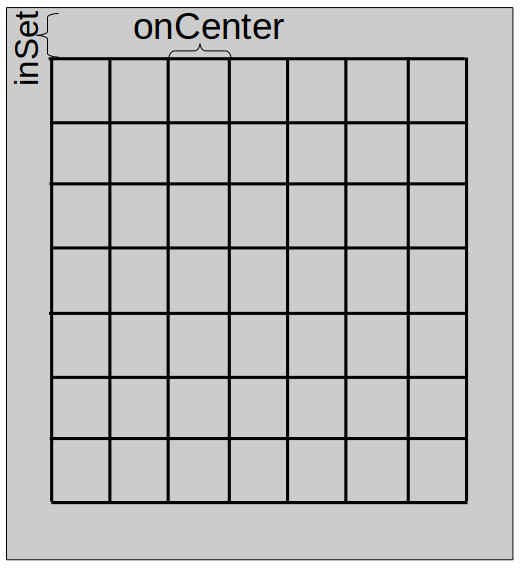The Weight of a Slab with Rebar calculator estimates the weight of a rectangular slab including rebar (if used).
INSTRUCTIONS: Choose units and enter the following: Rebar Grid - One Mat
Rebar Grid - One Mat
- (L) Length of Slab
- (W) Width of Slab
- (D) Depth of Slab
- (rS) Size of Rebar (none, 2-11,14,18)
- (i) Rebar Inset from the edge of the slab.
- (oC) on-center spacing of the rebar (default 18")
- (M) Number of rebar mats.
- (rL) length of the uncut rebar sticks
- (LF) Lapping Factor for rebar splices.
Weight of Slab with Rebar: The calculator returns the total weight in short tons (tons_us). However, this can be automatically converted into other weight units via the pull-down menu. The calculator also returns:
- (TW) Total weight of slab (concrete and rebar) in short tons
- (WR) Weight of Rebar in slab in pounds
- (WC) Weight of Concrete only in short tons.
- (V) Volume of Concrete in the slab in cubic yards (this accounts for the concrete displace by rebar if any).

Rebar and Slab Calculators:
- Rebar Calculator (Spanish Version: Calculadora de Barras de Refuerzo)
- Weight of Any Volume of Concrete
- Rebar and Concrete Volume and Weight in a Slab
- Rebar Weight
- Length of Rebar needed for a slab.
- Weight of Rebar in a slab.
- Weight, Volume of Concrete and Surface Area of a Concrete Slab
- Surface Area of a slab
- Surface Area of Concrete Forms.
- Volume of Concrete in a slab.
- Water Needed for Concrete
- Rebar and Concrete in a Slab
- Length of Rebar in Grid
- Weight of Rebar in Grid
- Rebar in a Wall
- Rebar in an Irregular Shaped Slab
- Rebar in a Circular Slab
- Rebar Lapping Length
- Rebar Cost Estimate
- Weight of Length of Rebar
- Concrete Displaced by Rebar
- Total Weight of a Slab with Rebar
General Information
The volume of concrete in the slab is defined by a length, width and a depth. Furthermore, the user chooses a rebar size including “none” to indicate no rebar. For rebar spacing, the user enters an on-center value in inches (defaulted at 18") , and an inset (default 3”) to designate the distance from the side of the slab to the first courses in the rebar grid. The user also specifies the number of mats (grids). Based on the rebar specs, the calculator computes the length, weight and volume of rebar in the slab. The total length of rebar is then multiplied by the pounds per inch based on the size of the rebar (3-11,14,18). The total volume of the concrete is multiplied by the unit weight constant (see constants) and the two are added together and converted to pounds or tons per the users designation. Finally, the weight is reduced by the volume of concrete displaced by any rebar.
Note: The actual weight may vary due to different types and consistencies of concrete and other factors. This equation is intended as an estimate only.
General Rebar Information
Rebar is short for reinforcing bar. Rebar is a roughly circular steel bar with ribs used to provide added tensile strength to concrete structures. Rebar is put in place before concrete is poured. When the concrete has hardened, the concrete around the rebar ribs keep the rebar in place. Rebar and concrete expand similarly with temperature variations. This all has the net result of substantially added tensile strength when rebar is part of the concrete form. Carbon steel is the most commonly used material for rebar, which may also be coated with zinc or epoxy resin.
Rebar is laid out in grids, crisscrossed patterns of rebar, tied at the intersections where runs of rebar touch. The grids have spacing between the rebar rows, and they are placed within the concrete form by a specified inset from the edge of the concrete. Multiple parallel grids, at uniform space intervals, are referred to as rebar mats.
Rebar Terms
- Rebar - reinforcing steel bar.
- Stick - one length of rebar. In the U.S., the most common lengths of rebar sticks are 20', 40' and 60'.
- Lapping - when two sticks of rebar are overlapped and bound together.
- Lapping Factor - the multiple of a rebar diameter used to specify appropriate rebar lapping length.
- Mat - a crisscross grid of rebar sticks. There may be more than one mat with space in between mats.
- Size - the indicator of the diameter of rebar sticks. Note: guage is not a correct term for rebar.
Rebar Size
In the United States, rebar sizes are in increments of 1/8th inches in diameter. Therefore, size 4 is 4/8th of an inch, which is 1/2", and size 8 is a full inch in diameter. Based on this and the density of steel used in rebar, the Rebar Size Table contains reasonably accurate specifications of rebar linear weight and lateral (face) area based on rebar size.
Rebar Lapping

The most common lengths of pre-cut rebar in the United States are 20`, 40' and 60'. These are known as rebar sticks. When the dimensions of a slab, wall or other form exceed the length of a single stick of rebar, it is required to rebar lapping length. The length of the lap is specified by a "Lapping Factor (LF)" which is often 40 or 60 times the diameter of the rebar. Engineering specifications of a lapping factor should always be applied.
Rebar Tools
A class of rebar tools, both powered and manual, have been developed to aid construction workers in working with rebar. These include the following:
- Rebar Cutters are used to cleanly and safely cut sections of rebar.
- Rebar Benders are used to bend rebar sticks precisely to fit into concrete forms.
- Rebar Tiers are used to tie rebar grid intersections and for rebar lapping.